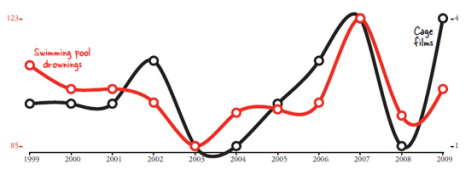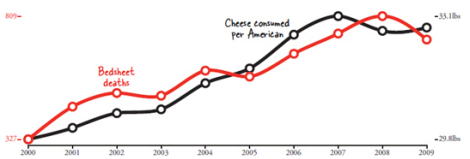Normally, people read a book first and then do a review of that book based on what they read. I’m going to do things a little backward and give you my review first and then go read the book. The book that I’m talking about is called Spurious Correlations by Tyler Vigen. It was released this year and focuses on that often repeated trope that correlation does not equal causation.
We all know it. But, like we know that we should eat healthy food, we don’t eat healthy food. We continually forget (or choose to ignore) the fact that because something has a high correlation doesn’t mean it is causally connected in any way shape or form.
My undergraduate degree (I say that as if I had an graduate degree, which I don’t) was in statistics. Actually, it was called quantitative business analysis – QBA. I know, that sounds so much more impressive. But the net-net is that I spent a lot of time working with numbers and relationships and statistics. So the concept of correlation and causation is very dear and near to my heart. So when I saw this book, I knew I had to read it.
And I had to read it because understanding this correlation/causation concept has never been more important in business. And when I say business I include HR.
Specifically HR.
And that is because if you are in HR you are being beaten over the head with the idea that you NEED big data. Everyone from the janitor to the CEO is on the big data train preaching that you need to measure everything, monitor everything, make sure that you digitize everything into neat little ones and zeros so you can pack it up into a nice database and then … wait for it… do the ANALYSIS.
And it is the push for more data and bigger databases for analysis that requires you have a more than passing relationship with and understanding of correlation. This is mission critical stuff because…
This quote from the review I read:
Beyond the humor, Vigen makes a serious point: spurious connections are becoming easier to find thanks to the increasing availability of large data sets and the tools to mine them. As science becomes more and more intertwined with “big data,” researchers must fight the urge to ascribe meaning to every association they discover.
That’s right. If you got data you are doing to do analysis and you are GOING to find relationships in that data. And you are going to present them in 16:9 PowerPoint slides to your C-Suite and you are going to show them the correlations and connections.
And you may be very, very wrong.
I’ll loop back when I finish the book but in the meantime – don’t believe everything you see in your statistics.
And by the way…. Did you know that there is a 97.8% correlation between the GDP of Australia and the number of Jennifer Lawrence films each year. No wonder she’s in everything. The Aussies are subsidizing her!
Have a great weekend. And weekends and fun are highly correlated too.







2 Pingbacks